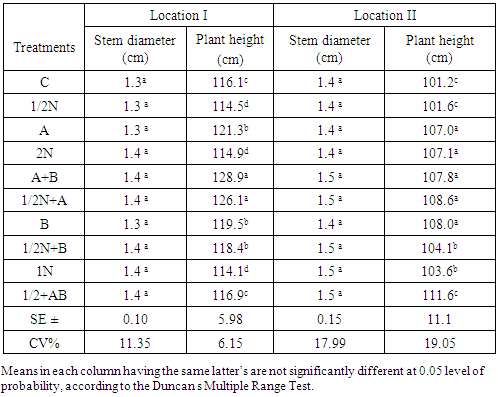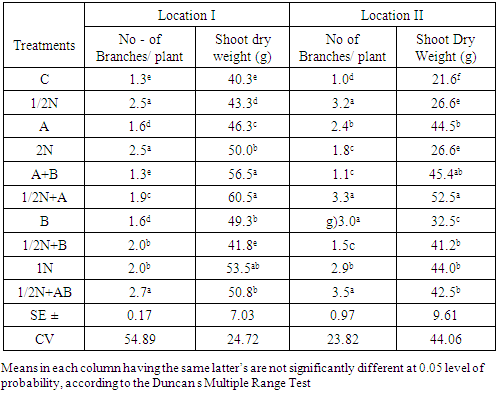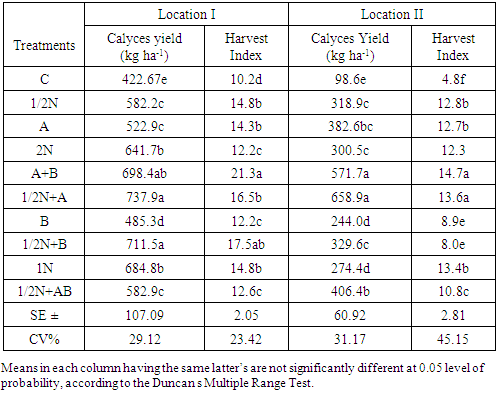-
Paper Information
- Previous Paper
- Paper Submission
-
Journal Information
- About This Journal
- Editorial Board
- Current Issue
- Archive
- Author Guidelines
- Contact Us
International Journal of Agriculture and Forestry
p-ISSN: 2165-882X e-ISSN: 2165-8846
2017; 7(6): 145-150
doi:10.5923/j.ijaf.20170706.05

Effects of Nitrogen and Bio-fertilizers on Growth and Yield of Roselle (Hibiscus sabdariffa var sabdariffa L.)
Ahmed M. El Naim1, Agwa I. Ahmed1, Khalid. A. Ibrahim2, Abdallateif M. Suliman3, Eltayeb S. N. Babikir4
1Department of Crop Sciences, Faculty of Natural Resources & Environmental Studies, University of Kordofan, Elobeid, Sudan
2Prince Sultan bin Abdul Aziz Center for Research & Environmental Studies & Tourism King, Khalid University, ABHA, Kingdom of Saudi Arabia
3Agricultural Research Corporation, Elobied Research Station, Sudan
4Department of Agronomy, Faculty of Agriculture, University of Khartoum, Khartoum, Sudan
Correspondence to: Ahmed M. El Naim, Department of Crop Sciences, Faculty of Natural Resources & Environmental Studies, University of Kordofan, Elobeid, Sudan.
| Email: |  |
Copyright © 2017 Scientific & Academic Publishing. All Rights Reserved.
This work is licensed under the Creative Commons Attribution International License (CC BY).
http://creativecommons.org/licenses/by/4.0/

The crop producers are aware of the need to reduce the use of chemical means of production and conducive to the development of biological alternatives. Bio-fertilizers have some microorganisms which convert elements to available nutrient for plant’s roots. A field experiment was conducted during 2010-2011 rainy season at two locations in North Kordofan State of Sudan. The aim of this study was to investigate the comparative efficiency of Nitrogen and Bio-fertilizers on growth and yield of roselle crop (Hibiscus sabdariffa var sabdariffa L.). The Ten treatments consisted of zero fertilizer, 1/2N (23Kg Nitrogen), 1N (46Kg Nitrogen), 2N (92Kg Nitrogen), Azatobacteria, Azospirillum, Azatobacteria+Azospirillum, 1/2N+Azatobacteria, 1/2N+Azospirillum, 1/2N+ Azatobacteria+ Azospirillum. A randomized complete block design (RCBD) with three replicates was used. The results showed that nitrogen and bio-fertilizers had a significant effect on most of the growth and yield attributes measured. The Nitrogen fertilizer (1/2N) and Azatobacteria treatment had a thicker stem diameter, a highest number of leaves per plant, number of productive branches, shoot fresh and dry weight and highest number of calyces per plant. The treatments (1/2N+ Azatobacteria) and (Azatobacteria +Azospirillum) had the highest plant height, dry calyx weight, harvest index and final calyx yield (kg ha-1).
Keywords: Fertilizer efficiency, Hibiscus, Azatobacteria, Azospirillum
Cite this paper: Ahmed M. El Naim, Agwa I. Ahmed, Khalid. A. Ibrahim, Abdallateif M. Suliman, Eltayeb S. N. Babikir, Effects of Nitrogen and Bio-fertilizers on Growth and Yield of Roselle (Hibiscus sabdariffa var sabdariffa L.), International Journal of Agriculture and Forestry, Vol. 7 No. 6, 2017, pp. 145-150. doi: 10.5923/j.ijaf.20170706.05.
Article Outline
1. Introduction
- Bio-fertilizers are live formulates of microorganisms (useful bacteria and fungi) that are ready to be used and improve the quality and the health of the soil and the plant species by increasing the nutrient availability for the soil and plants. Bio-fertilizers naturally activate microorganisms found in the soil natural fertility and protecting it against drought and soil diseases and therefore stimulate plant growth [1]. Bio-fertilizers were obtained using natural election of different type of beneficial living organism [2]. Using bio-fertilizers that contain different microbial strains has led to a decrease in the use of chemical fertilizers and has provided high quality products free of harmful agrochemicals for human safety [3]. Roselle (Hibiscus sabdariffa L) family Malvaceae, known commonly as "Karkade”. It is known under different names in different countries viz roselle, razelle, sorrel, red sorrel, Jamaica sorrel, Indian sorrel, Guinea sorrel, sour -sour, and Queens land jelly plant [4]. It is an important crop in tropical and sub-tropical regions. The economical part of the plant is the fleshy calyx (sepals) surrounding the fruit (capsules). In Sudan fully developed fleshy calyx is peeled off from the fruit by hand and dried naturally under shade to give the dry (calyx), which is the consumable product. The plant, normally grown as annual plant, is 0.5 to 1.5 meters in height. It has a bushy shape with somewhat dense canopy of dark green leaves. The colour of the calyx plays an important role in determining the quality of the crop. The crimson red colour is the characteristic and most popular and desirable colour of roselle while other shades and colors exist, including the white or greenish white colour. It is an important cash crop in Western Sudan, particularly in Northern Kordofan State where the largest area of roselle is grown (Elrahad and Um-Rawaba locality). The crop is mostly produced in traditional growing conditions by small-farmers, depending on rainfall and natural soil fertility without using chemical fertilizers or insecticides [5]. Roselle has many industrial and domestic uses. It is used as a beverage in the Sudan, where the dried calyx is soaked in water to prepare a colorful cold drink. Traditionally the product has been used for medicinal purposes for relief of sour throat and for healing wounds as an anti-septic [6]. El Naim et al. [6] reported that, leaves is consumed as green vegetable in many parts of the world and the stem is used as a source of pulp for paper industry. Seeds used as a poultry feed and as an aphrodisiac coffee substitute [25]. The main production comes from Western Sudan States, and the most of the exported crop is grown in the Eastern Kordofan localities. Roselle is also scattered in the southern region and south Fung area and recently at Abu Naama in the rain-fed central clay plains of Sudan [7, 8]. The production of Roselle in Sudan is facing many problems, which resulted in: unstable total production. The main yield-limiting factor is the amount and distribution of rainfall. Another problem is the labour requirement for harvesting which amounts to about half the total cost of production. Moreover, the cultivars used for production are local types, which are characterized by low yield potential. Most of the traditional farmers sow the crop in a very wide space, which affects the total production as well as poor cultural practices, low soil fertility and inadequate weed control. The crop is considered as a possible future crop, because of its natural production without using any chemical (fertilizers or insecticides). The uses of bio fertilizers in agriculture play an important role of providing an economically viable level for achieving the ultimate goal to enhance productivity. On the other hand, the value of organic materials as a source of plant nutrients is greatly enhanced by composting. Composted materials are also more stable and pleasant to handle. In North Kordofan State no trials have yet been carried out to evaluate the response of roselle to biological fertilizers. This study was under taken with an aim to study the beneficial effects of biological and chemical fertilizers and their various combinations on growth and yield of rosselle (Hibiscus sabdariffa L) under rain-fed condition in North Kordofan state of Sudan in semi-arid environment.
2. Materials and Methods
2.1. The Experiment
- A field experiment was conducted during season 2010-2011 under rain fed condition at two locations in North Kordofan state located between latitude 11° 15' and 16° 30' N and longititude 27° and 32° E, which were: Elobied Agricultural Research Station Farm and Khour Tagat (8 km East of Elobeid). The climate of the area is arid and semiarid zone. The soil is sandy with low fertility. Annual rainfall ranges between 350-500 mm. Average maximum daily temperatures varied between 30°C to 35°C most of the year [5, 9]. The aim is to study the comparative effects of nitrogen and bio-fertilizers on growth and yield of roselle (Hibiscus sabdariffa var sabdariffa L.). The experiment was laid out in Randomized Complete Block Design (RCBD) with four replications. The plot size was 5×4 meters. The treatments consisted of ten levels of fertilizers (nitrogen and bio-fertilizers) as follows: No fertilizer, 23kg nitrogen, Azatobacteria, Azospirillum, Azatobacteria + Azospirillum, 23Kg Nitrogen + Azatobacteria, 23kg Nitrogen + Azospirillum, 23Kg Nitrogen + Azatobacteria + Azospirillum, 46 Kg Nitrogen and 92 kg Nitrogen. Designated as C, ½N, A, B, AB, ½NA, ½NB, ½NAB, N, 2N respectively.Azatobacteria and Azospirillum strains used in this study were obtained from the Bio-fertilization Department, Environment and Natural Resources Institute, National Centre for Research, Khartoum, Sudan.Sowing dates on 16th of July for Elobeid Agricultural Research Station farm and Khour Tagat respectively. Seeds were sown on lines in spacing of 70 cm between rows and 60 cm within row, five seeds were placed in each hole. The plants were thinned to two plants per hole two weeks later.
2.2. Growth Attributes
- A sample of four plants was taken at random from inner rows in each experimental unit to measure the following growth attributes:- Plant height: measured from the ground level to the tip of the plant. - Stem diameter cm: Measured by using a Vernier (caliper) at second node. - Number of leave per plant:- Number of branches per plant: determined by counting reproductive branches at harvest.- Number of node per plant: was determined by counting the number of differential nodes of the main stem. - Shoot dry weight (g): by weighed dry at 85°C for 24 hours to constant weight.
2.3. Yield Attributes
- A destructive sample of four plants (uprooting) was taken at random from the five inner rows of experiment plot to measure the following attribute:- Number of calyces per plant (at 95% physiological maturity).- Calyces yield per plant (g): The calyces of four plants were peeled off from the capsules by using simple hand tools. The calyces were dried under shade to constant weight. Then average calices yield per plant (g) was determined. - Final calyces yield (kg ha-1): Calculated by using the following formula:
 - Harvest index was determined by using the following formula:-
- Harvest index was determined by using the following formula:-
2.4. Statistical Analysis
- The collected data were analyzed for the estimation of the statistical parameters according to Sigma stat procedure for a randomized complete block design (computer program). For comparison between means, they were separated using Duncan Multiple Range Test (DMRT) at 0.05 level of significance, according to the procedure described by Gomez and Gomez [10].
3. Results and Discussion
3.1. Growth Attributes
- Table 1 represents the effect of nitrogen and bio-fertilizers on stem diameter and plant height. The fertilizers had significantly effect on plant height. The AB treatment (Azatobacter +Azospirillum) had the highest plant height. Rajyalakshmi [26] found that inoculation of foxtail millet (variety Lepakshi) with three strains of Azospirillum lipoferum either alone or in combination with nitrogen fertilizer (40 kg N ha-1) increased the plant height, dry weight of shoot and root, and total N content of shoot, root and grain. Kamal (2008) found significantly increased plant height. Hassan et al. [29] reported that the bio-fertilizer rhizobactr application increased the vegetative growth (plant height, number of leaves, leaf area and dry weight). Zaki et al. [27] mentioned that broccoli plants treated with bio-fertilizer showed highest vegetative growth attributes: plant height, leaf number, fresh and dry weight of leaves and total yield.
|
|
|
3.2. Yield Attributes
- The Table 4 presented the effected of nitrogen and bio-fertilizers on number of calycies per plant. The treatment had a significant different on number of calyces per plant in the both locations. The bio-fertlizers and nitrogen treatments had highest number of calycies per plant compared to non-fertilizer treatment. A, A+B and 1/2N+A. treatments had a highest number of calyces per plant. Narula et al. [12] found that inoculation with Azotobacter and Azospirillum increased growth and yield parameters in cotton.
|
|
4. Conclusions
- The findings of this study have clearly showed that combined application of nitrogen and bio-fertilizers has resulted in obtaining highest plant growth, crop yields and dry matter production. It is concluded that plant height and biological yield have been affected significantly by co-inoculation followed by single inoculation because this bio-fertilizer can enhance absorbed of nitrogen by plant. Thus, it can be said that for obtaining maximum calyces yield from roselle, soil should be inoculated with Azotobacter with half dose of nitrogen and Azospirillum. We suggest that some other study should be carried out on the efficiency of bio-fertilizers.
 Abstract
Abstract Reference
Reference Full-Text PDF
Full-Text PDF Full-text HTML
Full-text HTML



